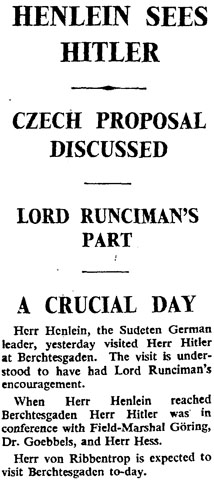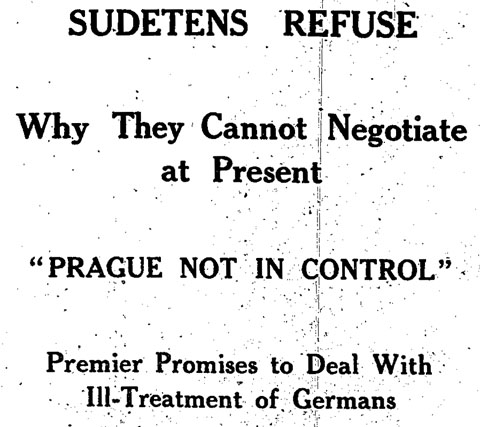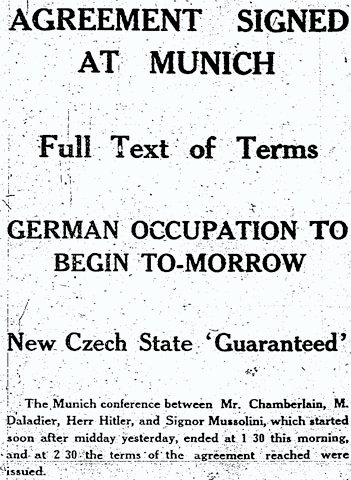
So Chamberlain, having flown to Germany yesterday, is still there, talking to Hitler. There’s no official word on what they talked about, but afterward Chamberlain appealed (via communique) for calm in the Sudetenland and other afflicted areas, or to be precise, he ‘appeals most earnestly, therefore, to everybody to assist in maintaining from action of any kind that would be likely to lead to incidents’ (this and the above headlines are from Manchester Guardian, p. 9). The situation in Czechoslovakia is indeed looking pretty bleak. The German press is reporting more of these ‘incidents’ (the Manchester Guardian uses scare quotes, too, p. 9), including a Czech official throwing a grenade into a crowd. They also report that the Czech army is withdrawing from the Sudetenland, blowing up bridges as it goes — the Manchester Guardian doubts that any such thing has happened (p. 9) but the Daily Mail‘s own correspondent, Paul Bretherton, has apparently seen this with his own eyes (p. 11. I say apparently because my printout is very poor quality at this point!) But it does seem true that two Sudeten towns have been evacuated by Czech authorities, and taken over by Sudetens (Manchester Guardian, p. 13). The Polish minority in the border town of Teschen has taken control of the Czech police stations there (Daily Mail, p. 11), or maybe they only attacked them (Manchester Guardian, p. 9). It’s very confusing, but in no sense reassuring. The British legation in Prague has instructed all British subjects to leave immediately, and an Imperial Airways H.P. 42 (Heracles, for the planespotters among you) has made a mercy dash to evacuate some of them (Daily Mail, p. 11). The other big news (Manchester Guardian, p. 9) is that the government of the Czech Prime Minister, Hodza, has resigned, to be replaced by a ‘national reconstruction’ cabinet under the Inspector General of the Army, General Jan Syrový, the popular one-eyed former commander of the legendary Czech Legion. It’s not a military government but it’s not a good look for democracy either.
The first leading article in the Daily Mail today (p. 10) is urging readers to stay the course and trust Chamberlain:
Those who hurl bitter accusations at the Prime Minister at this time are attacking his noble project at its foundations […] Much of the information which decided the Government’s policy is necessarily hidden from the public. The critics will find that the Prime Minister has a complete answer when he comes to make his statement to Parliament.
And the critics are multiplying. A crowd of nearly 10000 blocked Whitehall last night, nearly breaking through a police cordon two deep, backed up by 4 mounted police, according to the Daily Mail (p. 11. But the Manchester Guardian, p. 12, says the crowd numbered only three or four thousand: I’m not sure why the right-wing Mail would exaggerate the numbers or the liberal Guardian would minimise them?) The chants included ‘Chamberlain Must Go’, ‘Stand by the Czechs’, ‘Save Britain’, and ‘Stop Hitler’. Many more protests are being organised across the country this week-end: Labour is planning some two thousand, culminating in a big meeting at the Empress Hall in Earls Court on Monday night where Attlee will speak (Manchester Guardian, p. 8).
But there are those who support Chamberlain’s fight for peace. A deputation (including, among others, George Lansbury and Vera Brittain) from the Peace Pledge Union (which still exists) visited Downing Street in the Prime Minister’s absence and left a manifesto stating that nothing could justify a war (Manchester Guardian, p. 12):
The present crisis is the clearest possible example of historical retribution and a clear justification of pacifist policy. Blame undoubtedly attaches to Germany at the moment, but neither this country nor any other Great Power is less to blame for the present situation.
J. F. C. Fuller, decidedly not a pacifist, doesn’t want to add ‘unnecessary fuel to the present crisis’. His way of avoiding this is to make assertions such as (Spectator, p. 483):
I am further informed, on good authority, that in the Sudeten areas is to be found the highest death rate, suicide rate and infant mortality in Europe. Are these statements true or are they lies?
And to imply that the Soviet Union is pulling the strings behind the scenes in an attempt to start an ‘Imperialistic War’. Boney is a fully paid-up member of the British Union of Fascists — just so you know.
Some other bits and pieces. On 2 October, Hoare, the Home Secretary is going to launch a drive to recruit half a million ARP volunteers: 1.6 million posters are being printed, and the Football Association and the Greyhound Racing Association (among other sporting organisations) are going to broadcast appeals at their events (Manchester Guardian, p. 4). Which suggests to me that they are particularly trying to get working-class volunteers. There is speculation in Berlin that one fruit of the Chamberlain-Hitler meeting may be an ‘air pact’ (Manchester Guardian, p. 13). I’m not precisely sure what is meant by this; an air pact was the topic of much discussion in 1935, where it meant a sort of air Locarno, a mutual air defence pact. But I suspect that here it might be an agreement not to bomb each other’s civilians in wartime. The Manchester Guardian (pp. 10-1) has an article by an up-and-coming historian named A. J. P. Taylor comparing Czechoslovakia 1938 with Belgium 1830. He ends with a list of criteria for even temporary success in preserving peace, of which the last is:
(4) that there shall be as close an “ideological” bond between the Government of England and Germany as there was between between the constitutional monarchies of England and France a century ago. Of these conditions only the last seems likely of fulfillment.
Nice to see that AJP was always the controversialist! Lastly, another letter from a concerned parent: this time Therese Vogler wonders about the lack of gas masks for very young children (Spectator, p. 484):
A kind of gas-proof tent is, I believe, contemplated for infants in arms, but a frightened child between the unreasoning ages of eighteen months and four years could neither be kept forcibly enclosed for any length of time without suffering great terror, or induced to wear a gas-mask if it could possibly tear it off.
She wants to know ‘what chances there are, if any, for an adequate form of protection for small children’.
![]() This work is licensed under a Creative Commons Attribution-NonCommercial-NoDerivatives 4.0 International License.
Permissions beyond the scope of this license may be available at http://airminded.org/copyright/.
This work is licensed under a Creative Commons Attribution-NonCommercial-NoDerivatives 4.0 International License.
Permissions beyond the scope of this license may be available at http://airminded.org/copyright/.






The thing that is really interesting about these posts for me is how it’s shown me that this had a ‘street-level’ history as well as a diplomatic one. Riots, ‘atrocities’, attacks on police stations, rumour and hysteria: all these things haven’t found a place in the accounts of the period which concentrate on the IR aspects of it all. Nice.
Minor correction here: _Heracles_ doesn’t dash anywhere. It tops out at “amble.”
Hee. I made a funny about an “H” class. I could write for _Flight_. Now all I need is a tame stressman named Horace.
Seriously (so that’s my cue that the above was a joke, I guess), does anyone know if they were called “H 42s” prewar, or is this just an invention of Corelli Barnett? I can only recall the old birds being called by their individual names. And for those determined to find humiliation in the whole affair, what better example than a 10-year old four-engined biplane being sent to evacuate civilians. If only the new A. W.s were ready…
Chris:
Yes, you’ve put your finger on something there — kind of what I was trying to get at when I listed the Sudeten crisis in my post on unwritten books. There was so much more going on than the political and military moves, and I don’t think I’ve ever seen a serious treatment of the crisis at ‘street-level’ (good term!)
Erik:
I not that the Mail did use the word dash :) You may be right about the use of H.P. 42, I can’t find a mention of it in my notes (except where I’m paraphrasing) and a quick check suggests that names were used in the press, at least. At some point I guess it was decided that everything had to have a number …
Every design project would have had an H.P. number, and I read on Wikipedia (and if you can’t trust Wiki, who can you trust?) that HP42 and HP45 were assigned to the “H” airliners. I don’t know whether recognising that it is anachronistic to assign type numbers to ‘planes that were known at the time by their names, like ships is going to lead the cultural historian anywhere. If only I had access to the _Handley Page_ volume in the Putnam series out here in Vancouver…
What I do know is that –well, any chance to wrong foot Corelli Barnett is a chance to be taken.
The airliners were probably known as HP42’s by the aviation press and professionals at least initially; as the first flew before acquiring a name. (Might have been ‘Handley Page’s Airliner’, though. However the official paperwork would refer to a type number.) Type designations vs individual names vs fleet names are a tricky area to get right, and airlines and aircraft manufacturers get very upset when the other mandates an ‘official’ term for ‘their’ aircraft. Of course the general press do love to use the most entertaining name that comes to hand too, which hardly helps.
Sometimes that press invented name gets stuck, officially, to the type later – such as ‘The Flying Fortress’ invented by a pressman for the B-17, and adopted by Boeing and the USAAF, and discussed here by Brett, and I think the same for the ‘Jumbo Jet’ – something I’d imaging Boeing are having kittens about at the moment, as their rival manufacturer’s latest is getting called a ‘Super Jumbo’ in the press.
And… Just another person chiming in to say what a fascinating effort this ‘post-blog’ is, and I appreciate how much work it must be for Brett, but worthwhile and thought provoking – and not just airliner names either…
I suggest “HP 42” may have been known outside the aviation press and professionals. Source “An Album of International Air Liners”, issued by John Player & Sons (Brett, where do I apply for my product placement bribe – oops, fee?). Price One Penny. As you might guess, this is a collection of cigarette cards, and card number 4 says “Imperial Airways Liner “Horatius,” “Heracles” class (Great Britain). This is one of the two Handley Page 42 biplanes used on the Continental services of Imperial Airways……… ” No date on the album, but there is a card of a DC 3 in United Airlines markings, so 1937 at the earliest.
Hope this doesn’t disappoint anyone.
Great source find there, Ian, a good ‘vox pop-cough-uli’. Maybe we can collect our fur-trimmed anoraks on our way out…
Well, I’m glad we sorted that out! :)